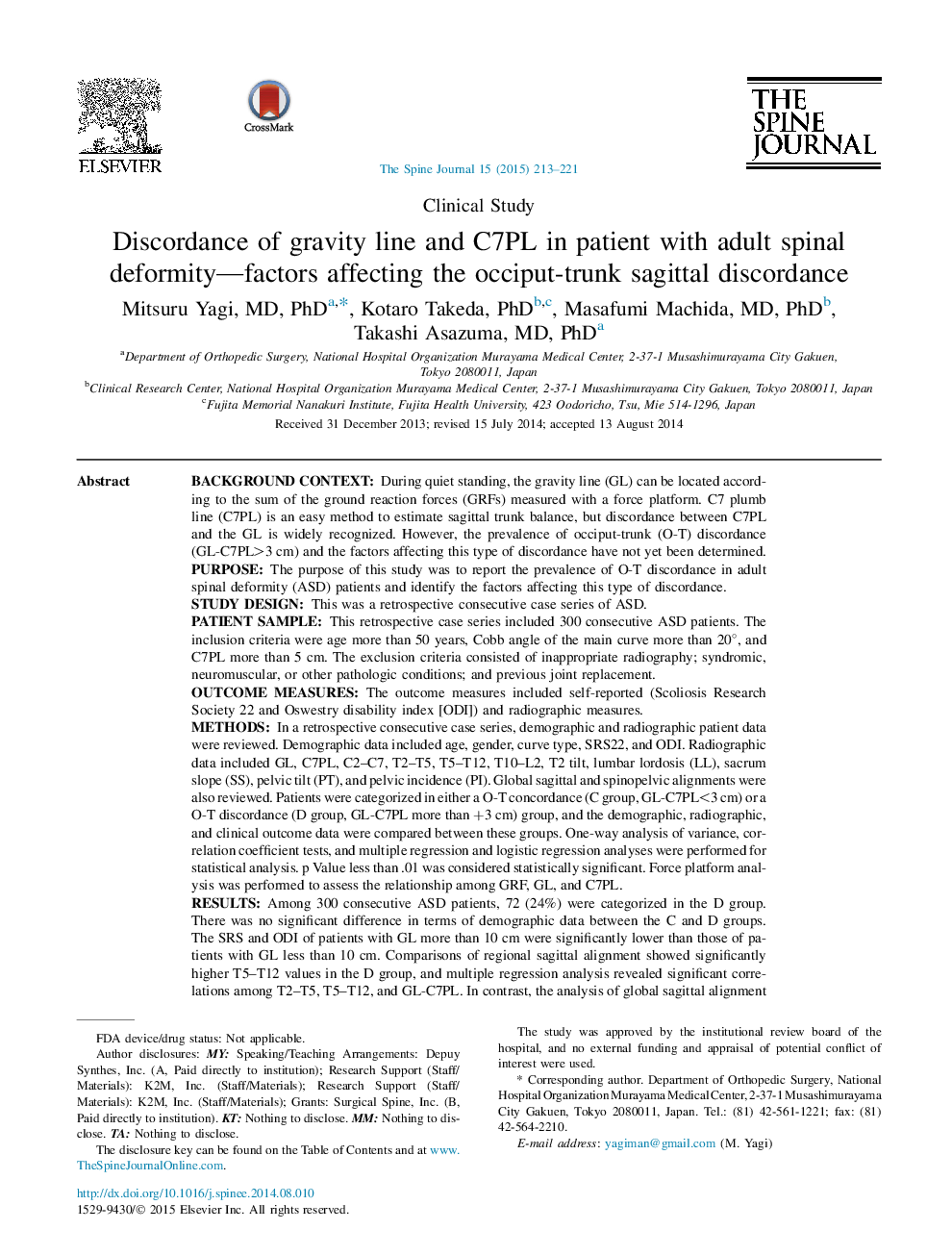| کد مقاله | کد نشریه | سال انتشار | مقاله انگلیسی | نسخه تمام متن |
|---|---|---|---|---|
| 4096534 | 1268565 | 2015 | 9 صفحه PDF | دانلود رایگان |

Background contextDuring quiet standing, the gravity line (GL) can be located according to the sum of the ground reaction forces (GRFs) measured with a force platform. C7 plumb line (C7PL) is an easy method to estimate sagittal trunk balance, but discordance between C7PL and the GL is widely recognized. However, the prevalence of occiput-trunk (O-T) discordance (GL-C7PL>3 cm) and the factors affecting this type of discordance have not yet been determined.PurposeThe purpose of this study was to report the prevalence of O-T discordance in adult spinal deformity (ASD) patients and identify the factors affecting this type of discordance.Study designThis was a retrospective consecutive case series of ASD.Patient sampleThis retrospective case series included 300 consecutive ASD patients. The inclusion criteria were age more than 50 years, Cobb angle of the main curve more than 20°, and C7PL more than 5 cm. The exclusion criteria consisted of inappropriate radiography; syndromic, neuromuscular, or other pathologic conditions; and previous joint replacement.Outcome measuresThe outcome measures included self-reported (Scoliosis Research Society 22 and Oswestry disability index [ODI]) and radiographic measures.MethodsIn a retrospective consecutive case series, demographic and radiographic patient data were reviewed. Demographic data included age, gender, curve type, SRS22, and ODI. Radiographic data included GL, C7PL, C2–C7, T2–T5, T5–T12, T10–L2, T2 tilt, lumbar lordosis (LL), sacrum slope (SS), pelvic tilt (PT), and pelvic incidence (PI). Global sagittal and spinopelvic alignments were also reviewed. Patients were categorized in either a O-T concordance (C group, GL-C7PL<3 cm) or a O-T discordance (D group, GL-C7PL more than +3 cm) group, and the demographic, radiographic, and clinical outcome data were compared between these groups. One-way analysis of variance, correlation coefficient tests, and multiple regression and logistic regression analyses were performed for statistical analysis. p Value less than .01 was considered statistically significant. Force platform analysis was performed to assess the relationship among GRF, GL, and C7PL.ResultsAmong 300 consecutive ASD patients, 72 (24%) were categorized in the D group. There was no significant difference in terms of demographic data between the C and D groups. The SRS and ODI of patients with GL more than 10 cm were significantly lower than those of patients with GL less than 10 cm. Comparisons of regional sagittal alignment showed significantly higher T5–T12 values in the D group, and multiple regression analysis revealed significant correlations among T2–T5, T5–T12, and GL-C7PL. In contrast, the analysis of global sagittal alignment revealed a significantly large T2 sagittal tilt in the D group compared with the C group. Force platform analysis showed concordance between GRF and GL, whereas discordance was observed between GRF and C7PL. The D group could be classified into 2 groups based on the global sagittal alignment: 10 patients were classified as the hypo-compensation type (small SVA, small CL, small TK, and normal-to-small LL), whereas 62 were classified as the forward-leaning type (large sagittal vertical axis, large cervical lordosis, large thoracic kyphosis, and small LL).ConclusionsThe prevalence of discordance between GL and C7PL in ASD patients was 24%, and thoracic kyphosis and global sagittal alignment were significantly correlated with this discordance. The concordance of GRF and GL and the discordance of GRF and C7PL highlight the importance and necessity of accounting for GL when considering surgical treatment.
Journal: The Spine Journal - Volume 15, Issue 2, 1 February 2015, Pages 213–221